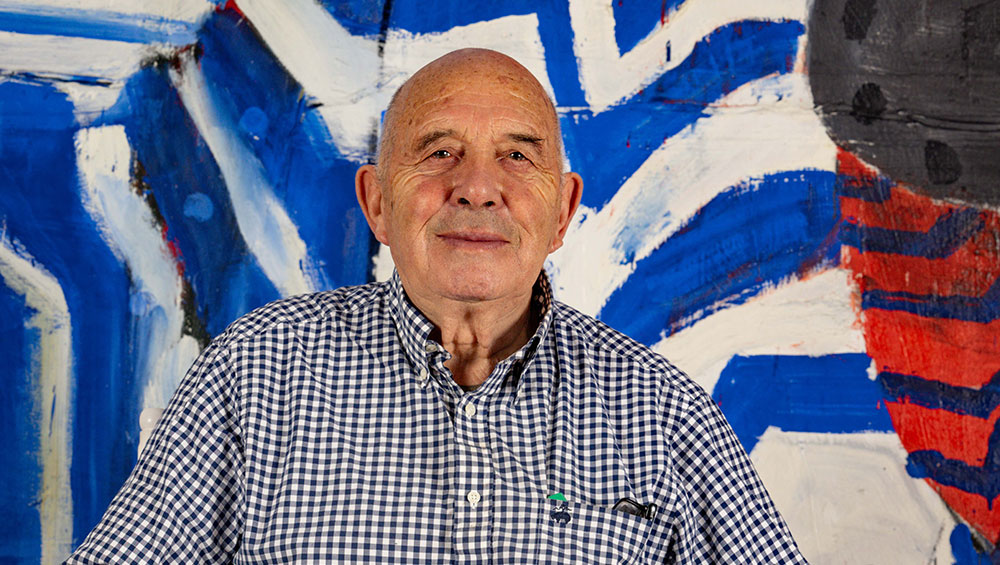
John Walker. Photo: Dave Clough, 2024.
by SAM CORNISH
John Walker was born in Birmingham in the UK in 1939. Having lived, painted and taught across the world, for many years he has been based in Maine in the US. His large-scale paintings mix abstract and figurative modes and engage with a broad range of international cultures. From the variety of his images emerges a consistent sense of being in the world, immersive, confrontational and intensely physical.
Sam Cornish: The new monograph on your work begins with a series of immersive details from your paintings. I would also like to start in and among the paintings by asking you about the role the horizon line plays in your images. Looking through the book, the horizon seems to move upwards. In the 1960s and 70s, the horizon line is aligned with the bottom edge of the canvas. By the 80s, it plays a more emphatic role, staging your large monolithic forms; while in many recent paintings it appears almost at the top of the image. Was this progression something you were conscious of as it happened, or does this sort of thing become clear only in retrospect?
John Walker: I grew up in industrial Birmingham where the horizon was always obscured by the industrial landscape. It’s not until later that I found myself in places where the distances were never obscured – in the American far west and then even more so in Oceania and especially Australia. Of course, there is a romantic idea – the romance beyond the horizon.
On reflection, the earlier work was always physically and visually confrontational and, for a short period, physical big space was what I sought, but at the same time it had to be intimate, I had to be able to touch it. When recognised in my painting, confrontational touch space was always part of the dialogue. The Maine landscape is much more intimate, and my painting becomes a conversation between the weather, the light and the forms, and the physical space of the canvas.
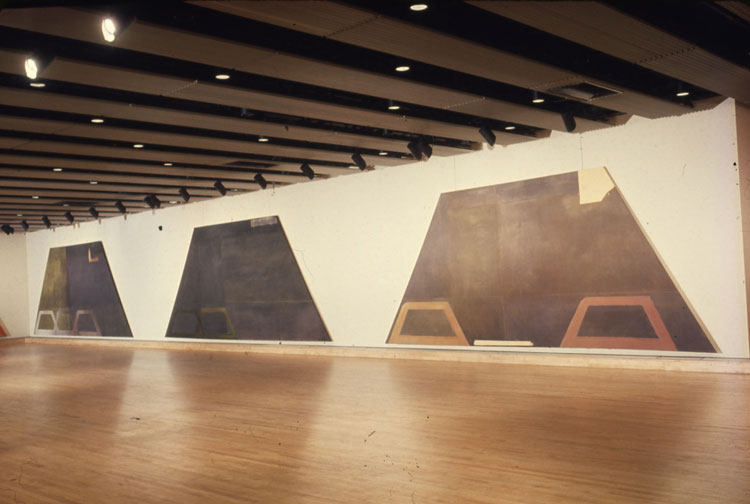
Installation view, John Walker: Paintings, Hayward Gallery, London, 1968. Courtesy of the Artist.
My wife says I am always saying that I paint what I see and, in fact, the horizon line in Maine is constant from the location where I paint. Given that, I am much more interested in what is below the horizon line than what is above it.
SC: I was intrigued by Catherine Lampert’s comment in her foreword that you are “guided by the quiet touch of the brush”. Touch seems to imply something delicate, intimate, but the very real tenderness of your paintings is also mixed with brusqueness, force, even a kind of violence. Do you see these qualities as opposed to each other or is it more complicated than that?
JW: Touch is a conversation that employs a whole range of sounds, if you like. Touch. as you’ve implied by your question, is all those things you suggest. One could say it’s the vocabulary of painting. Whether it is intimate or violent. It’s all hopefully accessible to the range of feelings that are available to me. One should never forget the intelligence of the hand and where that will lead you.
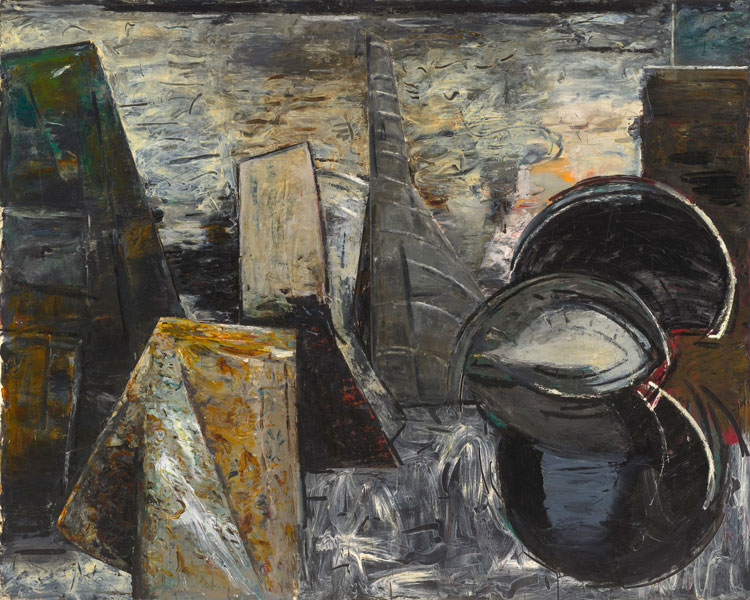
John Walker. Roundout Folly, 1980. Oil on canvas, 244 x 305 cm. Virginia Museum of Fine Arts, Richmond, VA. Gift of the Sydney and Frances Lewis Foundation. Photo: Troy Wilkinson © Virginia Museum of Fine Arts.
SC: There is a sculptural tendency in your work, whose tactility and physicality seems distinct from the activity of the brush, at least as commonly understood. I am thinking especially of the collaged planes of the 70s or the monolithic forms of the 80s. Can you say something about the presence of sculpture in your painting?
JW: I always felt that sculpture stopped after Brâncuși; Brâncuși satisfies all my inclinations for three-dimensional form, even though I have lots of friends who are sculptors. Going to his studio in Paris is one of the great events in life. The sculptural presence in my painting from the 70s was an endeavour to bring the picture plane to the surface of the paintings. When I look back at that series of paintings, they are the work of a young artist who grew up in an industrial city and created a facade of all that it implies.
SC: So the paintings are about disguise or deflection as much as revelation? Perhaps there is something similar in the relation of light and dark in your art. The creation of light is fundamental to some recent paintings; but in earlier paintings, light seems present to make apparent a surrounding darkness – whether of the picture, or beyond its limits.
JW: Growing up, I felt myself drawn to northern rather than to French art, influenced by the industrial landscape. I was always interested in the way Rembrandt constructs light, which was how I understood light to be.
I remember a book on Rembrandt, which has been debunked now, but which said that as a young man he used to work in his father’s mill. The children’s job in the mill was to get rid of the vermin. They did this by constructing a wicker cage in which they put a captured rat. They would hoist the cage up to the top of the mill, and leave it there, suspended in the light that came through the mill’s slit windows. The rat would go demented in the light and through thirst and so would drive the other rats out. I think that this was how Rembrandt constructed light.
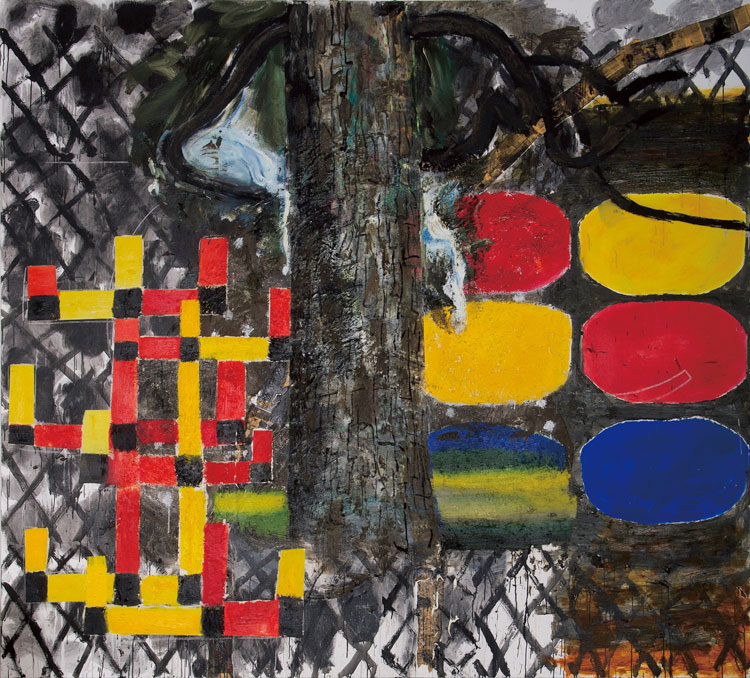
John Walker. John Constable's Tree, 2014. Oil on canvas, 274 x 305 cm. Eden Reiner.
SC: Without losing an essential directness, your painting is able to contain a wide array of quotations, often incorporating the work of other artists, often from very different historical or cultural contexts. I am interested especially in the cross-cultural range of your art. Is there a fundamental difference in your approach to the art of, say Oceania or Australia, compared with European artists, such as Constable? How conscious are you that aspects of these cultural contexts remain off limits to you?
JW: One of the most powerful exhibitions of painting that I have seen was the Constable exhibition of his large studies at the National Gallery in Washington DC, one of the strongest walls of pure paintings that I have ever witnessed.
As you are aware, I have lived and worked on several continents, including Australia, China and the US. It would be ridiculous to say that I have not been aware of these different cultures. They have influenced my art and have often been a challenge to what I bring to the studio.
Sometimes, the cultural exchanges have been difficult to absorb. But when I have included them with my work, I’ve always thought of them as companions to those ideas that I seem to have had most of my life as to what a painting is. For example, there was a series of paintings where I introduced the skull, mainly as a direct challenge to my abstracted forms. I wanted to confront my abstraction with my idea of reality. I became aware of the strong tradition in Oceania of people hanging their ancestors’ skulls in their homes as homage and respect. Hence titles of my work include “form and skull”.
Artists don’t have a lot of ideas. For instance, Philip Guston visited my studio and when I explained that I only had one idea, he said: “That’s why I come, because you have an idea and I like the way you deal with it.”

John Walker. Marat, 2023. Acrylic and collage on canvas, 274 x 396 cm. Photo: Dave Clough.
SC: Which contemporary artist (alive or dead) and which historic artist (or tradition) would you most like to show your recent paintings in relation to?
JW: This is a hard question, but one of the constants in my life has been several reproductions of Matisse’s large cutouts. If one replaces the word “cutouts” with “painting”, then they have to be one of the great painterly achievements of the last part of the 20th century for me. May I add that, in front of Goya’s Black paintings, I have wept uncontrollably. The guard was kind enough to offer his chair to me.
Contemporary artists I admire have often been friends, and I trust my friends with their own art. I am always honoured to hang work with my friends and do so as often as possible.
Among art that haunts me for instance is Titian’s Flaying of Marsyas and if the world was on fire, I would rescue Rembrandt’s Jewish Bride. I have never seen a more emotional painting of such profundity.
I have reproductions of the Rembrandt and the Titian paintings in my studio. So, in a sense, I am already having the conversation of who I would like to show with.
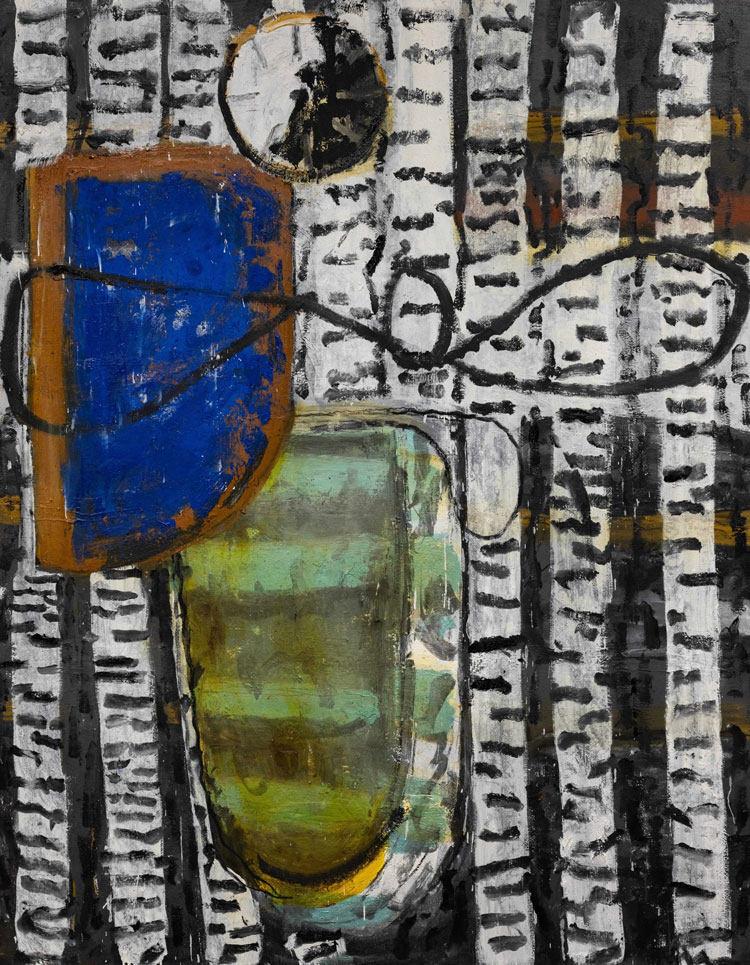
John Walker. Infusion I, 2024. Oil on canvas, 213 x 168 cm. Photo: Dave Clough.
SC: Can you tell me the name of your most recently completed painting, and describe it?
JW: My most recent paintings are a series of six, titled Infusion, which is a comment on my medical history at this time.
• John Walker is published by Thames & Hudson, price £50.

John Walker's studio, Penaquid, Maine, 2024. Photo: Dave Clough.